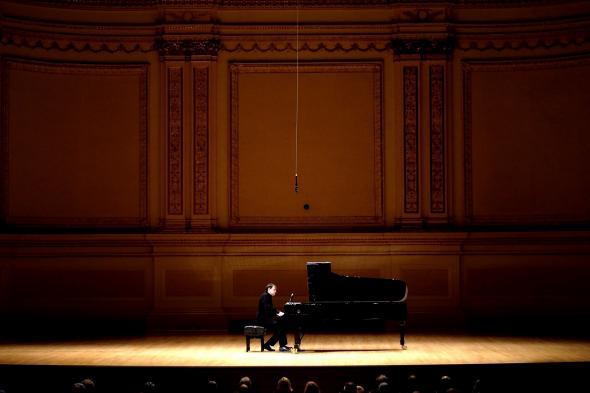This question originally appeared on Quora, the best answer to any question. Ask a question, get a great answer. Learn from experts and access insider knowledge. You can follow Quora on Twitter, Facebook, and Google Plus.
Answer by Curtis Lindsay, classical pianist and composer:
The word legato literally means “connected” or “bound together.” It means that notes follow one another smoothly—legato is the unimpeded constancy of sound and tone.
If you sing a simple rising scale on a pure vowel like [α] (“ah”), then your voice is producing a pure legato; the uninterrupted air-stream ensures that, though the pitches are changing, the sound does not stop.
The constant air stream available to a singer or wind player, or the continuous vibration caused by the constant contact between bow and string on a cello, means that legato is naturally available to those instruments and is considered an idiomatic component of their technique.
The first thing to understand about legato at the piano is that it is an illusion. The piano is not really capable of a true legato. That’s because it’s a percussive instrument. What’s more, it’s a doubly percussive instrument: You strike a key, which causes a hammer to strike a string. Slap your hand against your leg or some other surface. That’s what the hammer does to the string. It’s a percussion instrument.
Imagine standing behind a xylophone player at her instrument. She’s ready with mallets in hand. You tap her on the shoulder, and then she strikes one of the wooden bars with a mallet. That’s essentially how the piano works—nothing legato about it.
However, because the tone produced by the piano strings when they are struck decays slowly, it is possible to produce the illusion of legato at the piano when joining one keystroke to the next, and this is one of the fundamental problems in piano technique. When a pianist speaks of legato, he is really talking about pulling a fast one on the ear—making it sound as if the notes are connected. In classical playing especially, and sometimes in jazz and other styles, depending on the player, the development of a clear legato technique is of great importance.
Legato at the piano has two basic components:
1. Spit-second timing. As one key is released, the next one in the sequence is depressed so as not to leave a gap between the sounds. This requires very carefully chosen fingerings, and, in certain kinds of passages, coordination from the wrist and the larger muscle groups further up the arm. The basic principle becomes second nature with ample practice, but pianists are always working to refine their motion and timing toward a better legato.
2. Graded velocity in keystrokes. An important part of the illusion of legato is management of the force with which the keys are depressed. If we sing the phrase at top in a comfortable range of the voice, no one note is going to be noticeably louder or softer than the others unless we consciously try to make it so, because the air stream is kept relatively constant in pressure by the muscular apparatus that controls breathing. In playing the same phrase on the piano, though—which is a series of percussive events, as we have said—we have to work carefully to make sure that no note sticks out inappropriately. We do this by listening closely and making split-second judgments about how hard to depress the next key in a sequence based on the decay of the previous sound, so that the notes blend together into a phrase. If the phrase in question requires a crescendo or decrescendo, that of course must also be factored in. Evenness in finger strength is crucial to this sculpting of the sound, as is a sensitive, well-maintained piano. Pianos with unreliable or inconsistent key or hammer action make legato playing much more difficult than necessary.
Delicate assistive shading from the sustain pedal of the piano is a part of legato technique in certain instances, but the sustained ringing provided by the pedal is not a substitute for finger-hand legato except in very special circumstances as required by the music, and using it as such is one of the signs of an underdeveloped piano technique. This is a very common problem in piano-playing, one against which teachers sometimes struggle mightily with their students. We don’t want to make them afraid to use the pedal—it’s “the soul of the instrument,” as the composer Francis Poulenc said—but we also don’t want them to make a habit of using the pedal to hide deficiencies in fingering. This habit is quite quickly formed and very difficult to break.
A consistent, beautiful legato is extremely difficult to achieve on the piano and is a lifelong study. A good teacher will work tirelessly to instill and manage from the earliest stages the kind of physical motions and critical listening required for the endeavor.
As to how one knows when legato is required, this is a complicated question. Sometimes it’s a part of the stylistically appropriate performance practice of a certain type of piece, and no special indication in the music is required. Sometimes it’s signaled by the Italian word legato or the French word lié; often it is denoted by the presence of a slur marking, as in the musical example linked above.
More questions on Quora:
